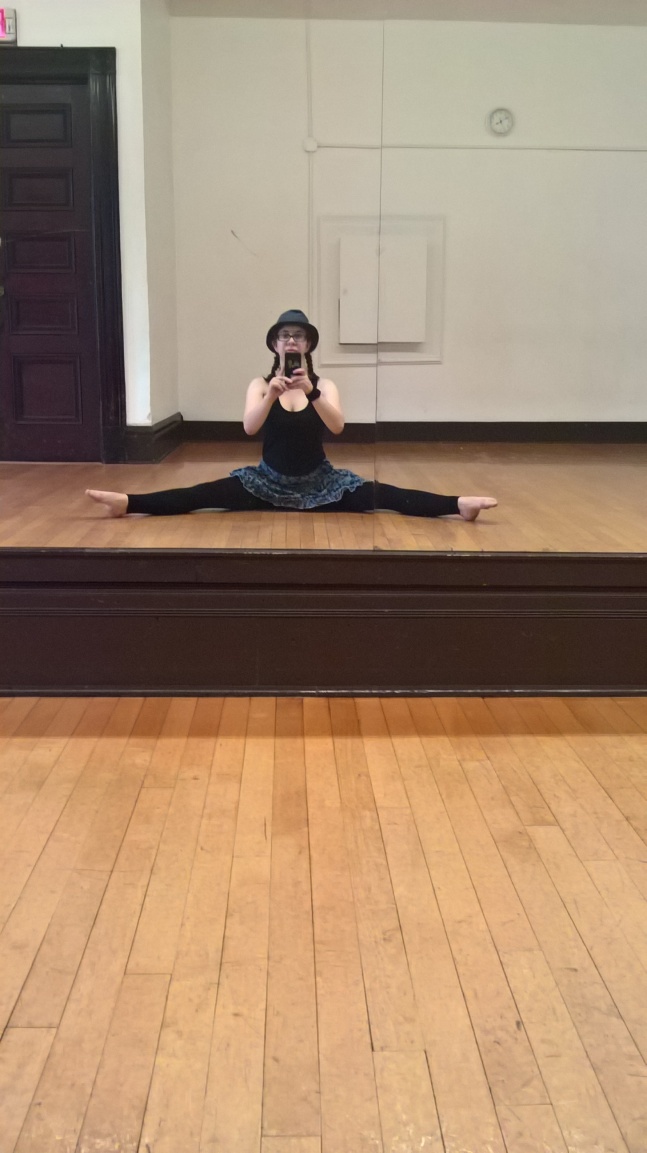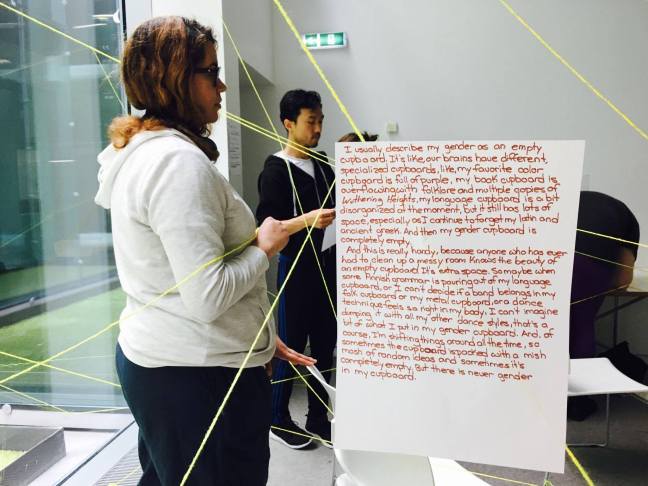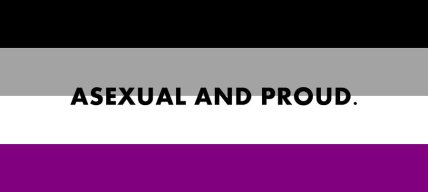Today we’re joined by Jo Troll. Jo is a phenomenal dancer who has recently branched out into what they term artistic intervention. They do a lot of Irish dancing and they have danced contemporary styles in the past. They’re currently focused on tackling cisnormativity in dance. It’s clear they’re a passionate and dedicated artist with an important message, as you’ll soon read. My thanks to them for taking the time to participate in this interview.

WORK
Please, tell us about your art.
I’m a dancer/choreographer that’s branched out into installation art and other methods of “artistic intervention”. I’m originally an Irish step dancer who strayed from the path and got really interested in contemporary dance. After a year at a conservatoire, I got really fed up with the value system in a lot of contemporary dance worlds and have been moving back towards Irish dance. I say Irish dance because that includes contemporary (but not competition) Irish step, older styles of step dancing, and sean-nos, an improvisational percussive dance form. Recently, a lot of my work has centered around my trans identity and trans visibility, and I’m currently at a point of transition where I’m trying to figure out how to tackle other concepts while continuing to challenge cisnormativity in dance.
What inspires you?
Anger. Anything that makes me even the slightest bit angry. I even made a whole piece about anger inspired by the respectability politics I was managing at my school at the time (I’m also super petty and may have built an installation based on how to most inconvenience someone that was being transphobic). It’s hard to exist in the world without being angry and it’s even harder as someone with multiple invisible identities (nonbinary, trans, asexual, aromantic…) who is usually read as female because anger is so much more likely to be invalidated by people in power. Performing is my chance to express my anger and make people listen. If you pay to go see someone, you’re a lot more likely to listen to them than if they try to challenge you in the middle of a conversation. Even if you should probably listen in both circumstances (this is a very general you).

So, when I was ten, my mom was really sick of driving me to soccer games and bribed me out of soccer with Irish dance lessons. That’s the main story. I’ve had a lot of beginnings in dance, but I’ve probably known since I was eight or so that I was going to be a dancer. Since ten is actually a late start for dance, I’ve had a lot of insecurities which kept me from voicing that for a long time and gotten in my own way a lot of the time, but it’s always been knowledge that this was what I was going to do, not a wish or a desire.
Do you have any kind of special or unique signature, symbol, or feature you include in your work that you’d be willing to reveal?
Well, everyone that knows my work (i.e. the wonderful friends that help me workshop things) claim that it’s distinct. I’d say that’s more because there’s not a lot of non-competitive dancers doing work around queer identity than because there’s anything particular to me. The most signature thing that stays true between pieces is costume – I always wear a hat and I almost always wear a skirt. The hat is just because I like hats and feel vaguely naked without one. The skirt is a very specific form of protest – people struggle to see feminine FAAB nonbinary people as nonbinary because we don’t fit the standard “androgynous” look deemed acceptable for FAAB folks. So, when I do have all the power to make people listen, I want to look as feminine as possible while I do it.
What advice would you give young aspiring artists?
If a system isn’t working for you, that’s not your fault. It’s always fine to leave, say “no”, or even make your own system. This is very true for dance – it took me a long time to learn that if a ballet teacher made me feel icky, I didn’t have to go to their class – but I feel like it is probably true for other forms of art too. There are infinite ways to make things. If something doesn’t work for you, there’s always another way.
Also, surround yourself with people that care about your work. I have a great list of people I trust to give me both encouragement and constructive feedback. It is impossible to make work in a complete vacuum (there are artists who have tried, I know), so be picky about who you work with, and find the people who truly want to make your art as strong as it can possibly be, because that is how you will find support and growth.

ASEXUALITY
Where on the spectrum do you identify?
Aroace. Probably.
Have you encountered any kind of ace prejudice or ignorance in your field? If so, how do you handle it?
Hehe. Quite recently, I was speaking on a panel on queer dance and I was responding to a question about asexual dance when I was interrupted mid-thought by another panelist who went on to talk about how they would never apologize for putting sex into their work. There’s a habit in dance, especially in queer dance, to focus on the sexual and see the nonsexual and the asexual as restrictive, backwards, and uninteresting. I can make work about transness and be brave. If I make work about asexuality, I’m regressive and “hurting the cause”.
I haven’t found my answer yet, but I’m working to really figure out what it means to dance asexually. I can make statements and comments as much as I’d like, but the most important thing is to keep owning the work that I make and who I am. If someone feels the need to go on the defensive about it, that’s their problem.
What’s the most common misconception about asexuality that you’ve encountered?
Heh. I think the biggest thing I see in dance, especially in queer art circles, is that somehow or other, asexuality threatens or denies the ability to claim and own other sexualities. Or, in other terms, that asexuality desexualizes other sexualities. I understand the threat for queer artists queer sexuality of all forms has been under attack for a long time, but it becomes a problem when this is used as an excuse to silence asexual voices. The possibility of asexuality does not negate the possibility of other queer sexualities, it is simply an expansion of what queer sexuality can be, which I find super exciting. I don’t have as much patience or understanding when allo, cis, straight dancers get up in arms about this too, but it does tell me that sexuality brings up lots of feelings for everyone. We just have to slowly untangle them. I would prefer it if all allo dancers would bother to look up the definition of asexuality before getting defensive though.
What advice would you give to any asexual individuals out there who might be struggling with their orientation?
It’s OK to struggle. These things aren’t always easy. All you can do is own where you are right now.
Surround yourself with things that make you feel good. Books with characters you relate to. Music that speaks to your heart. People that make you smile and feel like you are worth something. There are loads of recommendations out there for the young acespec and that can be helpful if you don’t know where to start, but don’t feel guilty if the thing that’s right for you isn’t in the ace community hivemind, or even explicitly ace-related. Take what’s right for you.
And make art. Art is a powerful tool for self-care and self-expression. Find the way it works for you and use it.
Finally, where can people find out more about your work?
I’ve got a website: jotroll.wordpress.com
And I blog a lot: jotdancing.wordpress.com
You can also find me on Facebook at: https://www.facebook.com/jotrolldance/
And on Tumblr at: https://jotrolldance.tumblr.com/

Thank you, Jo, for participating in this interview and this project. It’s very much appreciated.
